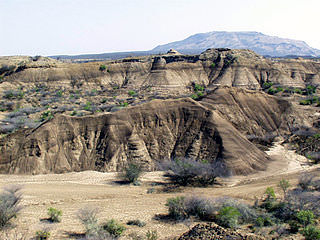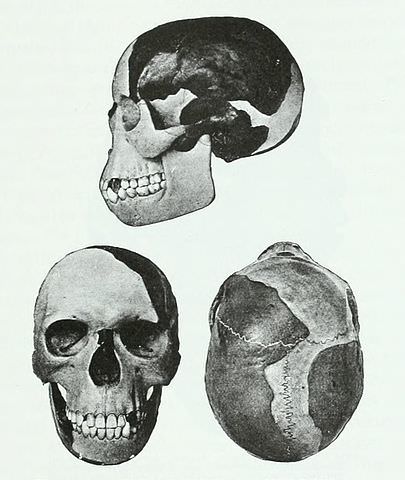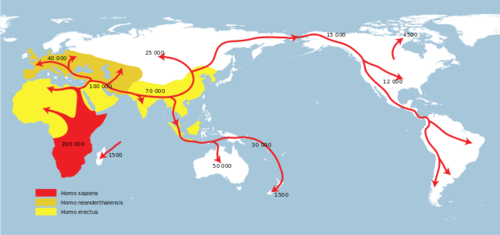7.7 现代人类的演变
章节大纲
-
Cradle of Homo Sapiens
::萨比安同性摇篮The desolate region of Ethiopia shown in this photo certainly does not look very hospitable, but it is the cradle of our . The earliest of Homo sapiens were found here in the late 1960s, but they were not accurately dated until 2005, when they were found to be almost 200 thousand years old. They are the oldest modern human fossils ever discovered. At the time modern humans evolved in this region of East Africa, the climate was much wetter, so it would have been much more inviting for our ancestors . These ancestors were not identical to humans today, but they were close enough to be called anatomically modern humans.
::照片中显示的埃塞俄比亚荒凉地区当然看起来并不非常好客,但它是我们祖先的摇篮。最早的智人出生于1960年代后期,但直到2005年才找到准确的日期,当时发现他们近20万年。它们是有史以来最古老的现代人类化石。当现代人类在东非这个地区进化时,气候非常湿润,因此对于我们的祖先来说,气候会更诱人。这些祖先与今天的人类并不相同,但是他们距离太近,足以被称为解剖现代人类。Introducing Modern Humans
::介绍现代人类Anatomically modern humans are humans that are virtually indistinguishable in physical appearance from humans today. They belong to the genus and species Homo sapiens. The term anatomically is important to apply to early modern humans because it is not clear whether they were also capable of modern human behaviors, such as abstract thought and language. Behavioral modernity may have evolved much more recently than an anatomically modern body, perhaps not until as recently as 50 thousand years ago.
::解剖现代人类是人类,在物理外观上与今天的人类几乎无法区分。它们属于基因和基因物种。解剖术语对于适用于早期现代人类很重要,因为不清楚它们是否也有能力现代人类行为,如抽象思想和语言。行为现代化可能比解剖现代体更近一些,也许直到5万年前才发生。Compared to archaic humans such as Neanderthals, anatomically modern humans are more lightly built. As you can see from the Neanderthal and early modern human skulls , the modern human skull is higher and more rounded, the result of a larger forebrain. If modern humans have brow ridges, they are relatively slight. The shape of their skull gives them a vertical, or nearly vertical, forehead. The teeth, jaws, and face of modern humans are also smaller, and they have a prominent chin.
::与尼安德特人等古老的人类相比,现代的解剖人造得比较轻。从尼安德特人和早期的现代人头骨中可以看到,现代人头骨更高、更圆,是更大的前脑骨的结果。如果现代人有眉脊,则相对来说是轻微的。他们的头骨形状给了他们一个垂直的或近乎垂直的额头上。现代人的牙齿、下巴和面部也更小,他们的下巴也非常突出。Neanderthal skull
::尼内地头骨Modern human (Cro Magnon) skull
::现代人类头骨(Cro Magnon)Important Modern Human Fossils
::重要的现代人类化Any fossil that sheds light on the evolution of modern humans is important. However, some of the most significant finds include the first fossils of modern humans to be found, the earliest fossils of modern humans yet discovered, and the earliest fossils found on different continents.
::任何能够揭示现代人类进化过程的化石都是重要的。 然而,其中最重要的发现包括最早发现的现代人类化石、尚未发现的现代人类最早的化石和在不同大陆发现的最早的化石。Cro Magnon
::克罗马龙NameThe first fossils of early modern humans to be found were discovered in 1868 in a rock shelter (shallow cave) called Cro Magnon in southwestern France. The fossils represented a modern human from 27 thousand to 23 thousand years ago. These humans were given the name Cro Magnon. Many other Cro Magnon fossils and artifacts have since been found. The term Cro Magnon has now largely been replaced by early modern human, which refers to any Homo sapiens who lived prior to about ten thousand years ago.
::早期现代人类最早发现的化石是1868年在法国西南部称为Cro Magnon的岩石掩体(浅洞)中发现的。化石代表了27 000至23 000年前的现代人类。这些人类被命名为Cro Magnon。后来又发现了许多其他的克罗Magnon化石和文物。Cro Magnon一词现在基本上被早期现代人类所取代,它指的是在大约一万年前生活的智人。The so-called Cro Magnon people were very similar in appearance to modern Europeans. Adult male Cro Magnon individuals were 1.6-1.8 m (5 ft 4 in. to 6 ft) tall, which was 10-31 cm (4-14 in.) taller than adult male Neanderthals, and they were generally not as robust as Neanderthals. The modern human skull pictured represents a Cro Magnon man. His brain size was large, even for people today. The skull also shows the typical features of anatomically modern humans, such as a small face and prominent chin.
::所谓的Cro Magnon人与现代欧洲人非常相似。 成年男性Cro Magnon人身高1.6-1.8米(5英尺4至6英尺),身高10-31厘米(4-14英寸),比成年男性尼安德特人高10-31厘米(4-14英寸 ) , 他们通常没有尼安德特人那么强壮。 现代人类头骨图画的是一个Cro Magnon人。 他的大脑大小很大,甚至对今天的人来说也是如此。 头骨还展示了解剖现代人的典型特征,比如小脸孔和突出的下巴。Fossils Showing Human Origins and Dispersal
::显示人类起源和分布的化石Fossils of the earliest modern humans date back to 195 thousand years ago at the Omo site in Ethiopia, pictured above. The Omo fossils represent two different individuals from roughly the same time period. One of the individuals — called Omo I — was clearly a modern human. The skull has a flat face, high forehead, prominent chin, and rounded braincase. The other individual — called Omo II — is represented by a partial skull that is thicker and more rugged, and has a sloping forehead. Omo II may have belonged to an archaic human species that lived more-or-less contemporaneously with early modern humans represented by Omo I. Alternatively, Omo II may have been an early modern human with a mix of archaic and modern traits. If so, then this fossil shows that early Homo sapiens were characterized by more physical diversity than characterizes our species today.
::最早的现代人类的骨骼可以追溯到195年前的195年,如上图所示,在埃塞俄比亚奥莫场址,奥莫化石代表了大约同一时期的两个不同的人,其中一个人——称为奥莫一号——显然是现代人,头骨面板平坦,前额高,下巴突出,脑袋四舍五入。另一个人——奥莫二号——代表着一个更厚、更粗糙、更粗糙的骨骼。奥莫二号可能属于一个古老的人类物种,它与奥莫一号所代表的早期现代人类同时或多或少。另一个人,奥莫二号可能是一个早期的现代人类,具有考古和现代特征的混合体。如果是这样,那么,这个化石表明早期的人猿具有比今天物种特征更多的物理多样性。Other fossils of early modern humans provide evidence of their arrival in different parts of the world. Fossil evidence documents that early modern humans arrived in:
::早期现代人类的其他化石也证明了这些化石在世界不同地区的到来。-
South Africa by 115 thousand years ago
::15 000年前南非的15 000年前 -
Southwest Asia (now Israel) by 100 thousand to 90 thousand years ago
::西南亚(现为以色列)10万至90 000年前 -
Southeast Asia by 70 thousand years ago
::东南亚70 000年前 -
Australia by 50 thousand to 46 thousand years ago (probably arriving by simple boats or rafts)
::澳大利亚5万至4万6千年前(可能由简单的船或木筏抵达) -
Europe by 45 thousand to 40 thousand years ago
::四万至四万年前的欧洲 -
Northeast Asia (Siberia) by 30 thousand to 28 thousand years ago
::东北亚(西比里亚)30 000至28 000年前 -
North America by 16 thousand to 15 thousand years ago (probably via a temporary land bridge from Siberia to Alaska across the Bering Sea)
::北美16 000至15 000年前(可能是通过从西伯利亚到阿拉斯加穿越白令海的临时陆桥) -
South America by 15 thousand to 14 thousand years ago
::南美洲15 000到14 000年前
The way that early modern humans migrated throughout the world — including approximate dates — is shown on the map . On the map, you can compare modern human dispersal with that of earlier archaic humans (Neanderthals), as well as still earlier Homo erectus .
::早期现代人类迁移到世界各地的方式——包括大致日期——在地图上显示。 在地图上,你可以将现代人类的分散与早期古老人类(尼安德特人)以及更早的人体勃起者相比。This map shows how early modern humans populated the world.
::这个地图显示了现代人类如何早期 聚集在世界上。Modern Humans in Prehistory
::《史前现代人类》Based on fossil and archaeological evidence, it appears that anatomically modern humans first evolved about 200 thousand years ago in East Africa. Between about 100 thousand and 25 thousand years ago, they migrated throughout much of the Old World. According to the artifacts left behind, by 50 thousand years ago, they had started to exhibit modern behaviors. By about 28 thousand years ago (and much earlier in many places), they had replaced or absorbed all other known species of archaic humans, including Neanderthals. By about 16 thousand years ago, early modern humans had finally reached the New World.
::根据化石和考古证据,现代解剖学人类在20万年前在东非首次进化。在10万到25万年前,他们在整个旧世界迁移。根据5万年前遗留下来的文物,他们开始表现出现代行为。 在大约28万年前(在很多地方更早之前 ) , 他们取代或吸收了所有其他已知的古老人类物种,包括尼安德特人。 在大约16万年前,早期的现代人类终于到达了新世界。Filling in the details of this brief overview is not easy. All of these events are prehistoric, having taken place long before recorded history. Evidence for what happened in prehistory has traditionally come from fossils and archaeological artifacts. Now, evidence is available, as well. T he more evidence that accumulates, however, the more complex the situation appears. At least three different models have been proposed to explain how modern humans evolved, interacted with archaic human species, and ultimately peopled the Old W orld. They are called the replacement model , regional continuity model, and assimilation model.
::填写这一简要概述的细节并非易事。 所有这些事件都是史前事件,早在历史记录之前就发生过。史前事件的证据历来来自化石和考古文物。现在,证据也已经存在。然而,越积聚证据,情况就越复杂。至少提出了三种不同的模型来解释现代人类是如何演变的,如何与古老人类进行互动,最终又如何让老世界成为人。 它们被称为替代模型、地区连续性模型和同化模型。Replacement Model
::更换模式The replacement model is also called the “Out of Africa” model. According to this model, modern humans evolved from archaic humans only in Africa around 200 thousand years ago. Some of them then migrated to the rest of the Old World. Wherever they encountered archaic human populations, the modern human populations replaced them. This model suggests that all modern humans today share a relatively recent African ancestry. It also suggests that any physical differences now found between modern human populations must have evolved within the past 40 thousand years or so.
::更替模式也被称为“非洲出国”模式。 根据这一模式,现代人类从20万年前才在非洲的古老人类中演变而来。 其中一些人后来迁移到旧世界的其他地方,在他们遇到古老人口的地方,现代人口取代了这些人口。 这一模式表明当今所有现代人类都拥有较近的非洲祖先。 它还表明,现代人口之间现在发现的任何物质差异都必须在过去四万年左右内演变。Regional Continuity Model
::区域连续性模型The regional continuity model posits that modern humans evolved more or less simultaneously from local archaic human populations in many places in the Old World. M odern European people, for example, are thought to have evolved from European Neanderthals. Proponents of this model think that the common ancestor of all modern humans was Homo erectus, who lived in Africa 1.8 million years ago or earlier. They also think that intermittent contact and among evolving human populations throughout the Old World prevented any of the local populations from evolving into different species, although regional variation would be expected to develop.
::区域连续性模式假设现代人类或多或少从旧世界许多地方的当地古老人类中同时发展。 例如,现代欧洲人被认为已经从欧洲尼安德特人中演变。 这一模式的支持者认为所有现代人类的共同祖先都是180万年前或更早生活在非洲的直立人。 他们还认为,整个旧世界的间歇性接触和不断演变的人类人口间歇性接触阻止了当地任何人口演变成不同的物种,尽管预计区域差异将会发展。Assimilation Model
::同化模型模型The assimilation model takes into account data that cannot be explained by either the replacement model or the regional continuity model. It is also a compromise between these other two models. According to the assimilation model, the first modern humans evolved in Africa, and later migrated into other parts of the Old World. However, rather than simply replacing the local archaic human populations they encountered, the modern human migrants interbred with them, at least to a limited degree. The local archaic populations were partly absorbed and partly replaced by the modern human populations. In some cases, the archaic and modern human populations may have lived side by side for long periods of time, perhaps for thousands of years.
::同化模式考虑到了无法用替代模式或区域连续性模式解释的数据,也是另外两种模式之间的一种妥协。根据同化模式,非洲第一个现代人类进化,后来迁移到旧世界的其他地方。然而,现代人类移民与其简单地取代他们所遇到的当地古老人类人口,不如说在有限的程度上与他们交织在一起。当地古老人口部分被现代人口吸收,部分被现代人口所取代。在某些情况下,古老和现代人类人口可能长期并肩生活,也许几千年。The Three Models: Final Thoughts
::三模式:最后思想Which (if any) of these three models is the correct explanation for the evolution and dispersal of modern Homo sapiens ? Data can be cited in support of each model, but the assimilation model seems to be the best fit for the evidence, especially the DNA evidence. As more data are collected, a clearer picture may emerge of our recent evolutionary past. New methods of extracting and analyzing DNA are likely to shed the most light on what happened during this exciting period of human prehistory.
::这三种模型中的哪一个(如果有的话)是对现代智人进化和散布的正确解释?数据可以用来支持每一种模型,但同化模型似乎最适合于证据,特别是DNA证据。 随着更多的数据的收集,我们最近的进化过去可能会出现更清晰的画面。 新的DNA提取和分析方法可能最能说明人类史前这段令人兴奋的时期所发生的事情。Summary
::摘要-
Anatomically modern humans are humans that are virtually indistinguishable from humans today. They are placed in the species
Homo sapiens,
regardless of their antiquity, although the earliest anatomically modern humans may not have been behaviorally modern, as well.
::解剖学现代人类是人类,与当今人类几乎无法区分。 他们被安置在智人物种中,不管他们的古老,尽管最早的解剖学现代人类可能也不是行为现代化的。 -
Relative to archaic humans (such as Neanderthals), anatomically modern humans are more lightly built. Their skulls are also more rounded, have relatively slight brow ridges, a vertical forehead, a prominent chin, and relatively small teeth, jaws, and face.
::相对古老的人类(如尼安德特人)而言,现代的解剖人造得比较轻。 他们的头骨也比较圆,有相对轻微的眉脊、垂直前额、突出的下巴以及相对较小的牙齿、下巴和面部。 -
The first fossils of early modern humans were discovered in the 1860s in France, and they were
called
Cro Magnon. These fossils have been dated to about 27 thousand to 23 thousand years ago. These and all other modern humans that lived prior to about ten thousand years ago are now called early modern humans.
::早期现代人类的第一批化石是在1860年代在法国发现的,它们被称为克罗·马格农。 这些化石的日期在27 000到23 000年前。 这些和在大约一万年前生活的所有其他现代人类现在都被称为早期现代人类。 -
The fossils of the earliest modern humans date back to 195 thousand years ago at the Omo site in Ethiopia. Very early modern human fossils may have exhibited greater physical diversity than the diversity that characterizes our species today.
::最早的现代人类的化石可以追溯到195,000年前在埃塞俄比亚奥莫(Omo)的化石。 早期的现代人类化石可能比当今物种的多样性表现出更大的物质多样性。 -
Other fossils of early modern humans provide evidence of their arrival in different parts of the world. For example, fossil evidence documents that early modern humans had arrived in South Africa by 115 thousand years ago, but not in South America until about 15 thousand years ago.
::早期现代人的其他化石也证明了这些化石的到来。 比如,化石证据文件证明早期现代人早在一万五千年前就已经抵达南非了一万五千年前,但直到大约一万五千年前才抵达南美洲。 -
Fossil and archaeological evidence suggests that anatomically modern humans first evolved about 200 thousand years ago in East Africa, migrated throughout much of the Old World
between
100 thousand and 25 thousand years ago, exhibited modern behaviors by 50 thousand years ago, and were the only human species remaining by 28 thousand years ago.
::物理学和考古证据表明,现代解剖学人类在大约20万年前在东非首次进化,在10万至25万年前迁移到整个老世界的许多地方,在5万年前表现出现代行为,并且是28万年前剩下的唯一人类。 -
At least three different models have been proposed to explain how modern humans evolved, interacted with archaic human species, and ultimately peopled the Old
W
orld. They are called the replacement model, regional continuity model, and assimilation model. The assimilation model is best supported by currently available data.
::至少提出了三种不同的模型来解释现代人类是如何进化的,如何与古老的人类物种互动,最终是人造的老世界。 它们被称为替代模型、地区连续性模型和同化模型。 同化模型得到现有数据的最佳支持。
Review
::回顾1. How did the early modern humans differ anatomically from archaic humans, such as Neanderthals?
::1. 早期现代人类与古老人类,如尼安德特人,在解剖学上有何不同?2. Why are Cro Magnon fossils so well known? What dates have been assigned to the first Cro Magnon fossils that were discovered?
::2. Cro Magnon化石为何如此广为人知?发现的第一个Cro Magnon化石的日期是多少?3. Define the term early modern human.
::3. 界定早期现代人类一词。4. Create a simple timeline of the origin and dispersal of Homo sapiens.
::4. 建立一个简单的智人起源和散布时间框架。5. Compare and contrast the replacement, regional continuity, and assimilation models of human evolution.
::5. 比较和比较人类演变的替代、区域连续性和同化模式。6. Which model in question #5 best fits the evidence?
::6. 问题5中哪种模型最适合证据?7. For each hypothetical situation below, choose which model of human evolution (replacement, regional continuity, or assimilation) would best fit the description.
::7. 对于以下每一种假设情况,选择哪种人类演变模式(替换、区域连续性或同化)最适合描述。a. Some modern humans evolved in Europe.
::a. 一些现代人类在欧洲演变。b. Modern humans always outcompeted archaic humans for resources, and they did not interbreed with them.
::b. 现代人类在资源方面总是比老古老的人类要强,而且他们没有与人类打交道。c. Modern humans evolved in Africa, but later interbred with archaic humans.
:c) 现代人类在非洲演变,但后来与古老人类混为一谈。
8. Compare and contrast the Omo I and Omo II individuals.
::8. 比较和对比Omo I和Omo II这两个人。9. The first humans to inhabit the Americas were:
::9. 居住在美洲的第一批人类是:a. Homo erectus
::a. 人形体b. Neanderthals
::b. 尼内长者c. modern humans
::c. 现代人类d. B and C
::d. B和C10. Define the term anatomically modern humans.
::10. 定义现代人类解剖学术语。11. True or False: Early modern humans tended to be slighter — but taller — than Neanderthals.
::11. 真实或假:早期现代人往往比尼安德特人轻,但高。12. True or False: The earliest modern human fossils date back to between 27 thousand and 23 thousand years ago.
::12. 真实或假:现代最早的人类化石可追溯到27 000至23 000年前。13. True or False: Cro Magnons are in the species Homo sapiens .
::13. 真实或假:克罗马格农属于智人种。Explore More
::探索更多We've seen how the human species has evolved in the past, but how might we evolve in the future? Learn about some theories here:
::我们见过人类过去是如何进化的, 但我们将来如何进化呢?在这里学习一些理论:Check out this video to discover some interesting vestigial parts you may or may not have:
::看看这段视频 以发现一些有趣的 残余部分 你可能或可能没有: -
South Africa by 115 thousand years ago



